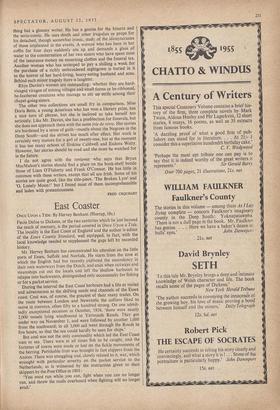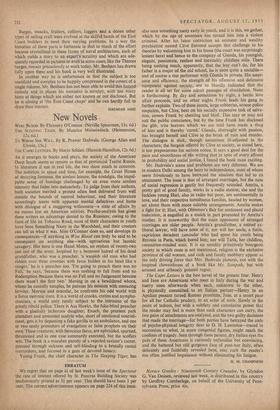East Coaster
ONCE UPON A TIDE. By Hervey Benham. (Harrap, 18s.) FROivi Defoe to Dickens, or the two centuries which lie just beyond the reach of memory, is the period covered in Once Upon a Tide. The locality is the East Coast of England and the author is editor of the Essex County Standard, well equipped, in fact, with the local knowledge needed to supplement the gaps left by recorded history.
Mr. Hervey Benham has concentrated his attention on the little ports of Essex, Suffolk and Norfolk. He starts from the time at which the English had but recently captured the ascendancy in their own waterways from the Dutch,.and ends when rai:ways and steamships cut out the locals and left the shallow harbours to relapse into backwaters, distinguished only occasionally for fishing or for a packet service.
During the interval the East Coast harbours had a life as varied and adventurous as the shifting sands and channels of the Essex coast. Coal was, of course, the greatest of their many trades. On the route between London and Newcastle the colliers liked to move in convoys, often fifty to a hundred strong. On one admit- tedly exceptional occasion in October, 1838, 'there were nearly 2,000 vessels lying windbound in Yarmouth Roads. They got under way on November 1, and were followed by another 1,000 from the southward; in all 3,0(X) sail went through the Roads in five hours, so that the sea could hardly be seen for ships.'
But coal was not the only commodity which led the East Coast men to sea. There were at all times fish to be caught, and the fortunes of towns were made or lost on the fickle movements of the herring. Perishable fruit was brought in fast clippers from the Azores. There was smuggling and, closely related to it, war, which wrought with particular severity on the packet service to the Netherlands, as is witnessed by the instruction given to their skippers by the Post Office in 1801: 'You must run while you can, fight when you can no longer run, and throw the mails overboard when fighting will no longer avail.' Barges, smacks, fruiters, colliers, luggers and a dozen other types of sailing craft were evolved at the skilful hands of the East Coast builders to meet their varying problems. In a way the historian of these parts is fortunate in that so much of the effort became crystallised In these forms of naval architecture, each of which yields,a story to an expert's scrutiny and which are ade- quately recorded in pictures or even in some cases, like the Thames barges, remain precariously at work today. Mr. Benham has drawn fully upon these and his book is very well illustrated.
In another way he is unfortunate in that the subject is too manifold and complex to. be happily compressed in the covers of a single volume, Mr. Benham has not been able to avoid this hazard entirely and in places his narrative is scrappy, with too many hints at things which are either not known or not disclosed. But he is aiming at 'the East Coast chaps' and he can hardly fail to



































 Previous page
Previous page